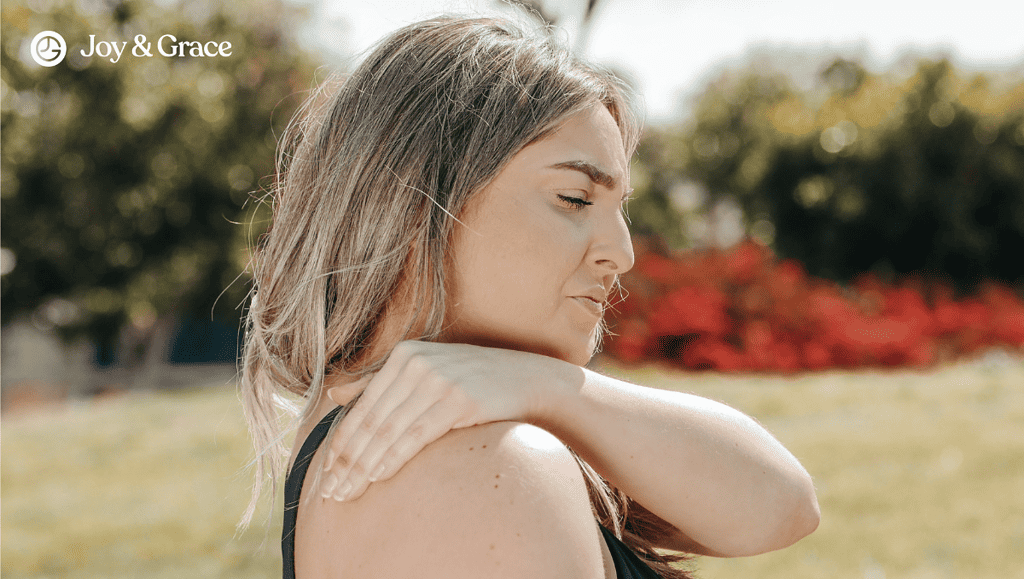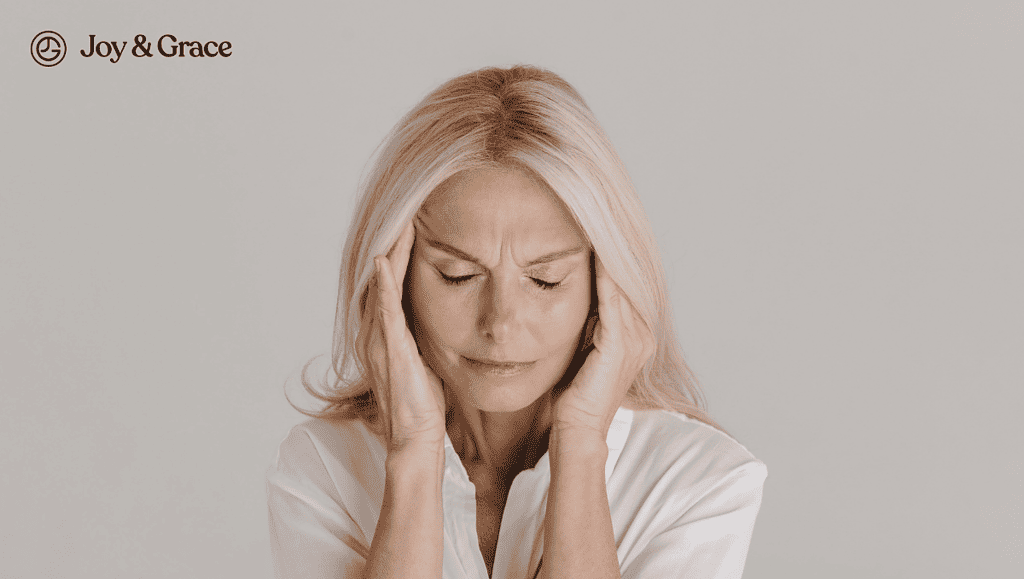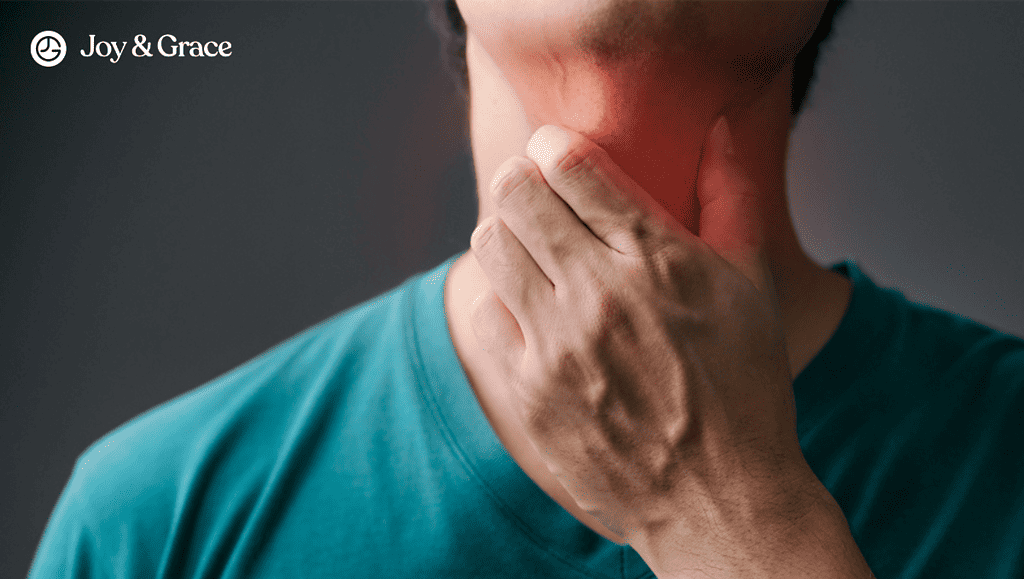Living with shoulder pain can be frustrating. But fear not! Acupuncture offers a natural and holistic approach to finding relief. This technique has withstood the tests of time and has helped countless people find relief from pain and regain mobility.
Join us as we uncover the secrets of acupuncture for shoulder pain. Learn about the science behind acupuncture points and when to consider acupuncture for shoulder pain.
Where Are The Acupuncture Points For Shoulder Pain?
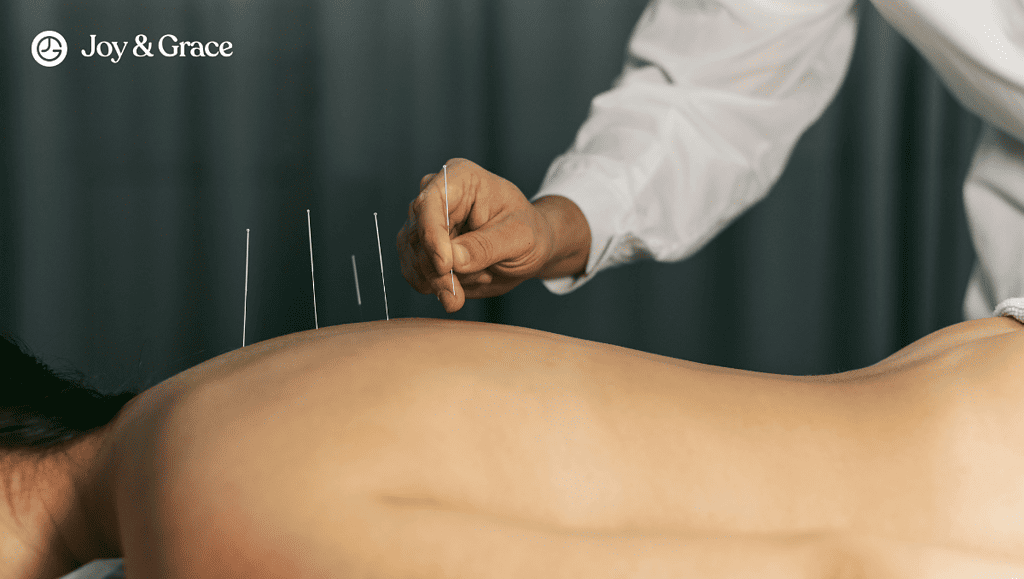
In the case of shoulder pain, several pressure points (too numerous to list down completely!) can provide relief when stimulated correctly.
In traditional Chinese medicine, acupuncture points are specific spots on the body where energy, or qi, tends to become blocked or stagnant. It is possible to release the trapped energy by applying pressure to these points, relieving pain.
So, where will the acupuncturist stick the needles in for shoulder pain? Well, here are some of the commonly used acupuncture points for shoulder pain:
Large Intestine 11 (LI11)
Large Intestine 11 (LI11), or Quchi, is an important acupuncture point for shoulder pain. LI11 is located at the lateral end of the elbow crease when the arm is flexed. It's known for its ability to reduce inflammation, alleviate pain, and improve range of motion. Stimulating LI11 may help restore the balance of qi in the affected area, providing relief from shoulder pain.
Large Intestine 14 (LI14)
Large Intestine 14 (LI14), or Binao, is another essential pressure point for shoulder pain relief. It is located on the lateral aspect of the upper arm, slightly above the elbow crease.
Large Intestine 15 (LI15)
Large Intestine 15 (LI15), or Jian Yu, is an effective pressure point for shoulder pain relief. It is situated on the upper edge of the shoulder, at the end of the deltoid muscle, when the arm is raised forward or sideways.
Applying pressure to Jian Yu may help reduce inflammation and promote blood circulation. This point is particularly beneficial for those suffering from pain and stiffness in the shoulder.
Lung 1 (LU1)
Lung 1 (LU1), or Zhongfu, can be found on the chest, in the hollow area just below the collarbone, and to the side of the breastbone. It is located right below LU2
Lung 2 (LU2)
Like LU1, Lung 2 (LU2), or Yunmen, is in the depression or hollow area just below the collarbone and to the side of the center of the chest.
Small Intestine 9 (SI9)
Small Intestine 9 (SI9), or Jian Zhen, is a key pressure point for shoulder pain relief. It can be found in the depression between the back of the shoulder joint and the shoulder blade’s upper border.
Small Intestine 11 (SI11)
Small Intestine 11 (SI11), also known as Tianzong or the "Celestial Gathering," is a powerful acupuncture point for shoulder pain. SI11 is located in the shoulder blade area. SI11 can be effective in treating pain and stiffness from conditions like frozen shoulder and rotator cuff injuries.
San Jiao 14 (SJ14) or Triple Burner 14 (TB14)
San Jiao 14, also known as Jian Liao, is another vital acupressure point for alleviating shoulder pain. It is located on the back of the shoulder, about one finger-width below the acromion process.
San Jiao 5 (SJ5) or Triple Burner 5 (TB5)
San Jiao 5 (SJ5), or Waiguan, is located on the forearm, about two finger widths above the wrist crease. It is a distal acupuncture point often used with other points to treat frozen shoulders.
Gallbladder 21 (GB21)
Gallbladder 21 (GB21), or Jian Jing, is another key pressure point for relieving shoulder pain. It is located on the top of the shoulder, midway between the neck and the edge of the shoulder.
Applying firm, circular pressure to this point may help reduce tension and muscle spasms and improve circulation. It is important to note that this point should be avoided during pregnancy, as it may stimulate uterine contractions.
Where Are The Acupuncture Points For Frozen Shoulders?
The acupuncture points we mentioned above can also be used to treat frozen shoulders. However, according to a study, Jian Yu (LI15) and Jian Liao (TB14) are the most commonly used points.
If you want to learn more about frozen shoulder (adhesive capsulitis), we have an article here.
Does Acupuncture Work For Neck And Shoulder Pain?
Research has shown satisfactory results supporting the use of acupuncture for neck and shoulder pain.
A clinical trial from 2006 aimed to investigate the effectiveness of adding acupuncture to routine care of chronic neck pain. Patients in the acupuncture group received up to 15 acupuncture sessions over three months. Meanwhile, patients in the control group received no acupuncture.
After three months, the acupuncture group had a 12.3-point greater improvement in neck pain and disability compared to the control group. The results suggested that adding acupuncture therapy to routine care can lead to greater improvement in neck pain and disability.
If you want to learn more about the benefits of acupuncture for neck pain, we have an article here.
Another study aimed to see if acupuncture is a good treatment for chronic shoulder pain. It also compared individualized and fixed acupuncture points.
The study (with inclusion criteria being shoulder pain for at least 8 weeks) separated the participants into three treatment groups:
- Individualized acupuncture
- Fixed acupuncture points
- Sham nonpenetrating acupuncture
After 6 weeks of treatment, all three groups showed improvement, but only groups 1 and 2 had a clinically significant improvement. In this way, the study concluded that acupuncture can be effective for chronic shoulder pain.
So, if you're feeling skeptical about needles, take a deep breath and relax. The research shows that you can trust your acupuncturist to hit the mark and relieve your pain!
Can Acupuncture Help Arthritis In Shoulders?
Acupuncture has been shown to help alleviate pain and improve mobility in people with arthritis.
This includes both rheumatoid arthritis and osteoarthritis.
However, it is essential to note that acupuncture is typically most effective as part of a comprehensive treatment plan. Treatment may include physical therapy, medication, and lifestyle changes.
Does Acupuncture Help Inflammation In The Shoulder?
According to research, acupuncture can regulate the production of pro-inflammatory and anti-inflammatory cytokines. Cytokines are proteins involved in the body's inflammatory response.
Can Acupuncture Repair A Torn Rotator Cuff?

While acupuncture cannot directly repair a torn rotator cuff, it can play a role in the overall treatment plan for this type of injury.
According to a review, electro-acupuncture can relieve pain and promote the repair of rotator cuff injuries in rat models. This may be due to reduced levels of inflammatory proteins (more on that later).
What Does Shoulder Pain Mean In Chinese Medicine?
In Chinese medicine, shoulder pain is often seen as a manifestation of an imbalance in the body's energy or Qi. Specifically, pain occurs when Qi (“chi”) or blood stagnates due to blockages.
These blockages can occur either due to injury or invasion by external factors. These factors are wind, cold, and dampness. In Chinese medicine, this is called “Bi syndrome.”
When these external factors invade and build up in the shoulder, the blood supply to the shoulder can become stagnant. This may lead to pain, stiffness, or restricted movement.

There are six types of Bi syndrome, each with its own symptoms and underlying causes.
- Wind Bi syndrome
This type of Bi syndrome is characterized by joint pain without a fixed location. People with Wind Bi may have an aversion to wind. In terms of shoulder pain, this may present as pain that moves around the shoulder joint capsule without being localized to a specific area.
- Cold Bi syndrome
Cold Bi is associated with a severe stabbing pain localized to a specific area and accompanied by a sensation of coldness. Symptoms may be alleviated by warmth and worsened by cold.
Regarding shoulder pain, this may present as a sharp pain in the shoulder that is worse in cold weather and relieved by heat.
- Dampness Bi syndrome
This type of Bi syndrome is characterized by soreness, fixed joint pain, and local swelling and numbness. Symptoms may worsen on cloudy and rainy days.
In terms of shoulder pain, this may present as a dull, achy pain in the shoulder accompanied by swelling and numbness.
- Heat Bi syndrome
Heat Bi is associated with joint pain accompanied by redness, swelling, and a burning sensation. People with Heat Bi may also experience fever, sweating, and thirst.
In terms of shoulder pain, this may present as a burning, throbbing pain in the shoulder joint.
- Blood Stasis Bi syndrome
This type of Bi syndrome is characterized by long-term intermittent joint pain. There may also be swelling, rigidity, and deformity of the joints. People with Blood Stasis Bi may also experience numbness of the limbs.
In terms of shoulder pain, this may present as chronic, achy pain accompanied by stiffness and deformity of the joint.
- Heart Bi syndrome
Heart Bi is associated with palpitations, chest tightness, and shortness of breath. People with Heart Bi may also experience bluish discoloration of the face, lips, and fingernails and have cold limbs.
In terms of shoulder pain, this may present as pain that radiates from the chest to the shoulder. The pain may be accompanied by shortness of breath and palpitations.
Another perspective in Chinese medicine associates shoulder pain with specific organ systems. These are the gallbladder, lung, large intestine, small intestine, and triple burner (San Jiao) organs. An imbalance in any of these organs is thought to manifest as shoulder pain.
The connection between shoulder pain and these organs is also evident in Western medicine. For instance, if you have acute cholecystitis or inflammation of the gallbladder, the pain can move to your right shoulder.
And similar to what we mentioned earlier, heart attacks can also present with pain that can spread to your shoulder.
Now, you might be wondering why these organs may cause shoulder pain when they’re nowhere near the shoulder. Well, according to ancient Chinese medicine, it all has to do with where the points of these meridians pass through. (Although modern medicine thinks otherwise. We have an article about the link-up between shoulder pain and those conditions here.)
What Are The Meridians Related To Shoulder Pain?
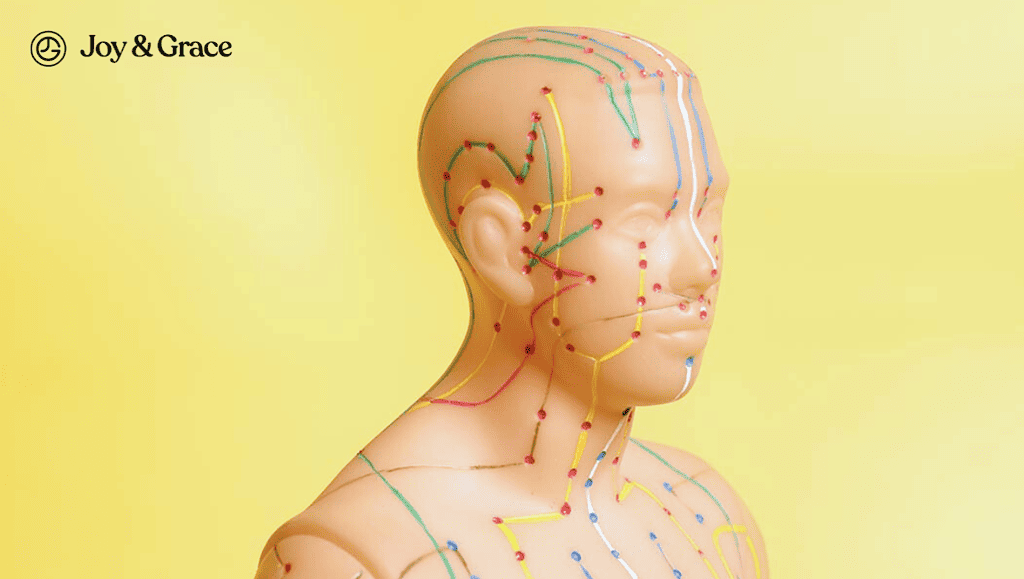
Ancient Chinese medicine describes shoulder pain to be related to several meridians. This is because the shoulder is a complex area with multiple muscles, tendons, and joints.
In Traditional Chinese Medicine (TCM), meridians are the pathways through which qi (life energy) flows in the body. There are 12 primary meridians, each associated with a specific organ system.
The following meridians are described to be commonly associated with shoulder pain:
- Large Intestine Meridian (LI)
This meridian starts at the tip of the index finger, runs along the arm, and ends at the nostril. It is often linked to shoulder pain as it passes through the shoulder joint.
Imbalances in the Large Intestine Meridian can lead to pain, stiffness, and restricted movement in the shoulder.
- Lung Meridian (LU)
Beginning at the chest, the Lung Meridian travels down the arm and ends at the thumb. It also has a connection to the shoulder, and imbalances in this meridian might contribute to shoulder pain.
Issues related to the Lung Meridian can manifest as pain, weakness, or respiratory problems.
- Small Intestine Meridian (SI)
Starting at the little finger, the Small Intestine Meridian runs along the arm, across the shoulder blade, and ends at the ear.
- Triple Burner (San Jiao) Meridian (SJ)
The Triple Burner Meridian starts at the tip of the ring finger, moves up the arm, and ends at the temple. It is responsible for regulating the body's energy and fluid balance.
An imbalance in this meridian can manifest as shoulder pain and other symptoms such as headaches or dizziness.
- Gallbladder Meridian (GB)
Although not directly passing through the shoulder joint, the Gallbladder Meridian runs along the side of the body, from the head to the foot.
It can indirectly impact shoulder pain due to its proximity to the neck and upper back area. Imbalances in the Gallbladder Meridian may lead to pain and tension in the shoulder, neck, or upper back.
While these meridians are more commonly associated with shoulder pain, others may also play a role:
- Heart Meridian (HT)
The Heart Meridian starts in the heart and travels down the arm to end at the little finger. It's less frequently associated with shoulder pain. However, specific points along the meridian, such as HT 1 (Jiquan), might be relevant in some instances.
- Pericardium Meridian (PC)
The pericardium Meridian starts at the chest, runs down the inner arm and ends at the middle finger. Points on this meridian, like PC 3 (Quze) or PC 4 (Ximen), may help alleviate shoulder pain for some individuals.
- Other Meridians
Although not directly related to shoulder pain, the remaining meridians could still impact the shoulder. These are the:
- Spleen
- Stomach
- Kidney
- Bladder
- Liver
A skilled acupuncturist will consider the interplay between meridians when selecting acupuncture points.
How Does Acupuncture Work For Shoulder Pain?
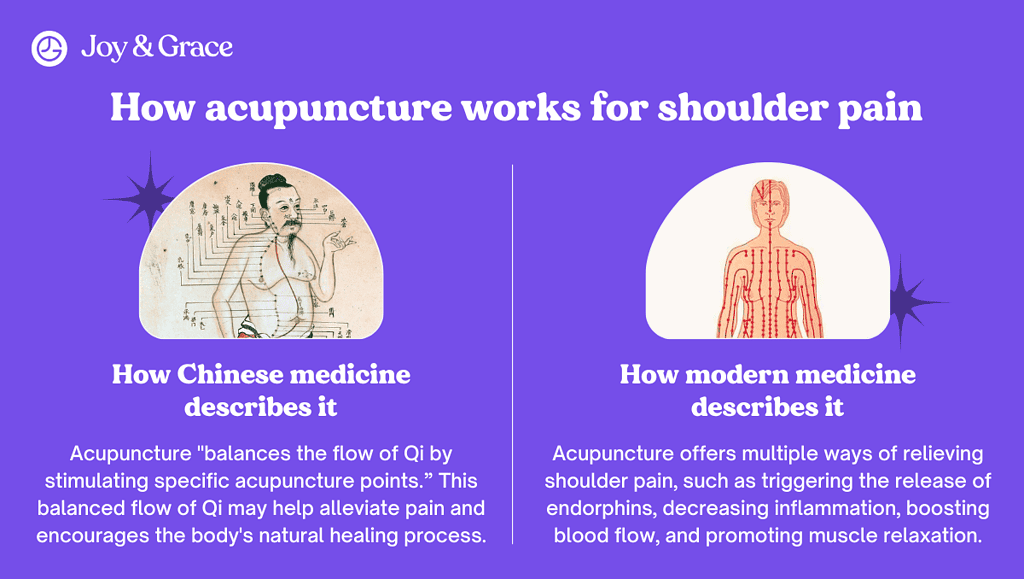
Acupuncture "balances the flow of Qi by stimulating specific acupuncture points.” This balanced flow of Qi may help alleviate pain and encourages the body's natural healing process.
That’s at least how ancient Chinese medicine describes it.
On the other hand, modern medicine says that acupuncture helps shoulder pain in different ways:
- Stimulating the release of endorphins
Acupuncture stimulates the release of endorphins, the body's natural pain-relieving chemicals. Endorphins block pain signals from reaching the brain, reducing pain.
The release of these endorphins also promotes relaxation, which also helps address shoulder pain.
- Reducing inflammation
Inflammation is a common cause of shoulder pain, often resulting from injury or overuse. As we mentioned earlier, acupuncture reduces inflammation by regulating the release of cytokines.
By reducing inflammation, acupuncture can alleviate pain and promote healing in the affected area.
- Increasing blood circulation
Proper blood circulation is essential for healing and overall health. Acupuncture can increase blood flow to the shoulder area. This allows essential nutrients and oxygen to reach the injured tissues. This increased blood flow can accelerate the healing process and help reduce pain.
- Relaxing muscles
Muscle tension or spasms can contribute to shoulder pain. Acupuncture has a relaxing effect on the muscles, helping to release tension and reduce muscle spasms. By relaxing the muscles around the shoulder, acupuncture can alleviate pain and improve range of motion.
How Many Acupuncture Sessions Are Needed For Shoulder Pain?
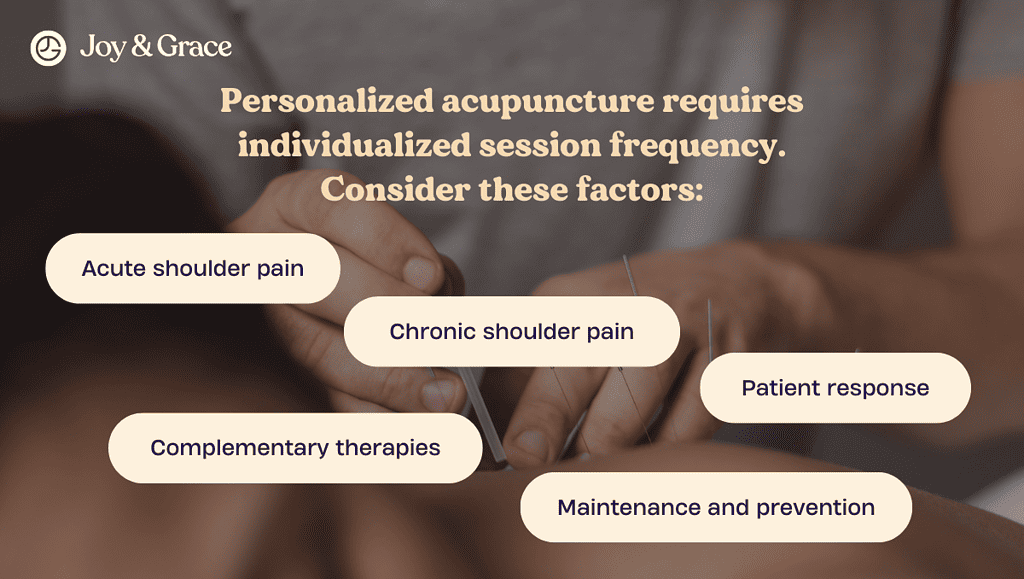
The number of acupuncture sessions needed for shoulder pain can vary depending on the following:
- The severity of the pain
- Underlying cause
- Your response to treatment.
Acupuncture is a personalized therapy, and each person's experience will differ. However, here are some things to consider when determining the frequency of acupuncture sessions.
- Acute shoulder pain
In cases of acute shoulder pain, such as a recent injury or a sudden onset of pain, more frequent treatments may be needed initially. However, there are no available guidelines on the exact number of sessions needed.
- Chronic shoulder pain
If you have been experiencing chronic shoulder pain, the treatment plan will likely involve fewer sessions per week. However, the length of the treatment may have a longer overall duration.
According to a study, 2 or more sessions per week or a dose of 30 minutes per week can provide greater pain relief. Additionally, the effects of acupuncture can last up to 18 weeks after treatment.
- Patient response
Each person responds differently to acupuncture. Some individuals may experience significant relief after just a few sessions. In contrast, others may require more extended treatment to see noticeable improvements.
- Complementary therapies
Your acupuncturist may recommend additional therapies, such as manual therapy. This may affect the number of acupuncture sessions needed to relieve pain.
- Maintenance and prevention
Once your shoulder pain has improved, you may consider ongoing maintenance sessions to prevent the recurrence of pain. The frequency of these maintenance sessions can range from once a month to once every few months.
It's essential to communicate openly with your practitioner about your progress. It's also important to voice any concerns you may have so they can adjust the treatment plan as needed.
How Long Does Acupuncture Take To Work For Shoulder Pain?
Similar to what we mentioned earlier, the duration it takes for acupuncture to relieve shoulder pain can vary from person to person. Some may experience rapid relief, while others may take longer to respond.
The following factors can impact the body's ability to heal and respond to acupuncture treatment:
- Age
- Overall health
- Lifestyle choices
- The severity of the pain
- The underlying cause of the pain
- Frequency of sessions
- Use of other treatments
What Should I Not Do Before Acupuncture?
Preparing for an acupuncture session is crucial to ensure the best possible outcome and experience. Here are some things you should avoid doing before your acupuncture appointment:
- Consuming a large meal
- Arriving on an empty stomach
- While it's not advisable to eat a large meal before acupuncture, arriving on an empty stomach is also not recommended.
- Drinking caffeine or alcohol
- Consuming caffeine or alcohol before acupuncture may interfere with the treatment's effectiveness. Caffeine can cause nervousness and make it difficult to relax during the session. Meanwhile alcohol may impair your ability to communicate clearly with your practitioner.
- Engaging in vigorous exercise
- Taking painkillers or sedatives
- Rushing to your appointment
- Wearing restrictive clothing
- Smoking before and after the session
What Should I Not Do After Acupuncture?
Here are some things you should avoid doing after your acupuncture appointment:
- Smoking
- Strenuous physical activity
- Taking a bath or a swim 1 hour after the session
When Should I Consider Acupuncture For Shoulder Pain?
Acupuncture can be an effective treatment for various types of shoulder pain. Consider acupuncture for shoulder pain in the following situations:
- Persistent pain
Acupuncture may be a viable option if you have been experiencing persistent shoulder pain despite routine care.
- Limited range of motion
Acupuncture can help alleviate stiffness and improve mobility in the shoulder joint.
- Inflammation
Acupuncture may reduce inflammation in the shoulder, providing relief from pain and discomfort.
- Muscle tension
If muscle tension is contributing to your shoulder pain, acupuncture can help relax these muscles and alleviate pain.
- Complementary treatment
Acupuncture can be used alongside other treatments to enhance its effectiveness. This can include medication and physical therapy.
Who Shouldn't Use Acupuncture?
Acupuncture is generally considered safe. However, certain individuals should exercise caution or avoid acupuncture altogether:
- Pregnant women
Acupuncture is considered safe for pregnant women. However, some acupuncture points can stimulate uterine contractions. This may be a risky adverse effect during pregnancy. Always consult with a qualified practitioner who has experience treating pregnant patients.
- Individuals with bleeding disorders
People with hemophilia or other bleeding disorders may be at an increased risk of bleeding or bruising. Inform your practitioner about any such conditions before treatment.
- Individuals with a pacemaker
The use of electroacupuncture can interfere with a pacemaker's function. Electroacupuncture involves passing an electrical current through the needles. Make sure to inform your practitioner if you have a pacemaker.
- Individuals with skin infections
Acupuncture should be avoided if you have an active skin infection or open wound in the area where needles would be inserted.
- People who are uncomfortable with needles
If the thought of needles makes you break out in a cold sweat, fear not! You're not alone. While acupuncture can be an effective treatment for many, it's understandable that some may feel a bit wary.
If you have a low pain tolerance or are simply not a fan of needles, there are plenty of other holistic treatments out there that may be more your style.
Self-Acupressure Techniques For At-Home Relief Of Shoulder Pain
Acupressure is a non-invasive form of acupuncture. It involves applying pressure to the acupuncture points on the body using your hands and fingers. It's acupuncture but without the needles.
One of the major advantages of acupressure is that you can do it yourself anywhere. So whether at home, work, or on the go, acupressure can be a convenient and cost-effective way to promote relaxation and healing. And best of all, the procedure is needle-free, making it a great option for anyone who's not a fan of being poked and prodded!
How Do I Locate And Stimulate Acupuncture Points For Shoulder Pain?

To effectively locate and stimulate acupuncture points for shoulder pain, follow these steps:
- Identify the key points
Go over the acupressure pressure points we mentioned earlier and try to familiarize yourself with their location on your body. You can also ask a licensed acupuncturist or a detailed acupuncture chart to help you identify their locations.
- Find a comfortable position
Sit or lie in a comfortable position where you can easily access the acupuncture points.
- Apply gentle pressure
Using your fingers, apply gentle yet firm pressure on the identified points. Press and hold for about 30 seconds, then release. You can also use a blunt, rounded tool like a pencil eraser or an acupressure stick.
- Massage the points
You can also gently massage the points in a circular motion for a few minutes.
- Move to other points
Work your way through the different acupuncture points related to shoulder pain. However, you don't have to treat all the acupressure points for a given pain area. Some points may be more effective than others, so focusing on those points can be just as effective.
- Repeat as needed
You can stimulate these points several times a day to help alleviate shoulder pain. However, be cautious not to overstimulate, as this can cause discomfort or bruising.
It's important to exercise caution when using acupressure. Avoid applying pressure to open wounds or swollen, inflamed areas. Additionally, avoid any areas with scar tissue, boils, blisters, rashes, or varicose veins.
Takeaway
Acupuncture is a traditional Chinese technique that has shown promise in relieving shoulder pain. It can help relieve pain from conditions like arthritis, inflammation, and rotator cuff injuries.
Acupuncture can help reduce pain, improve circulation, and promote healing. When used with conventional treatments, acupuncture can be an effective therapy for shoulder pain.







